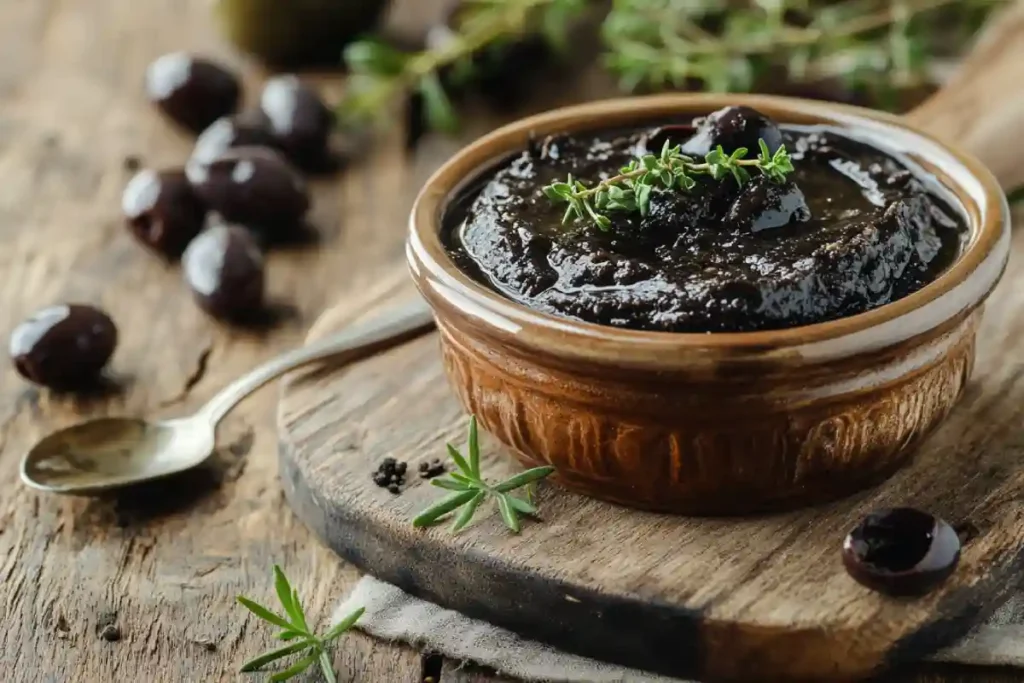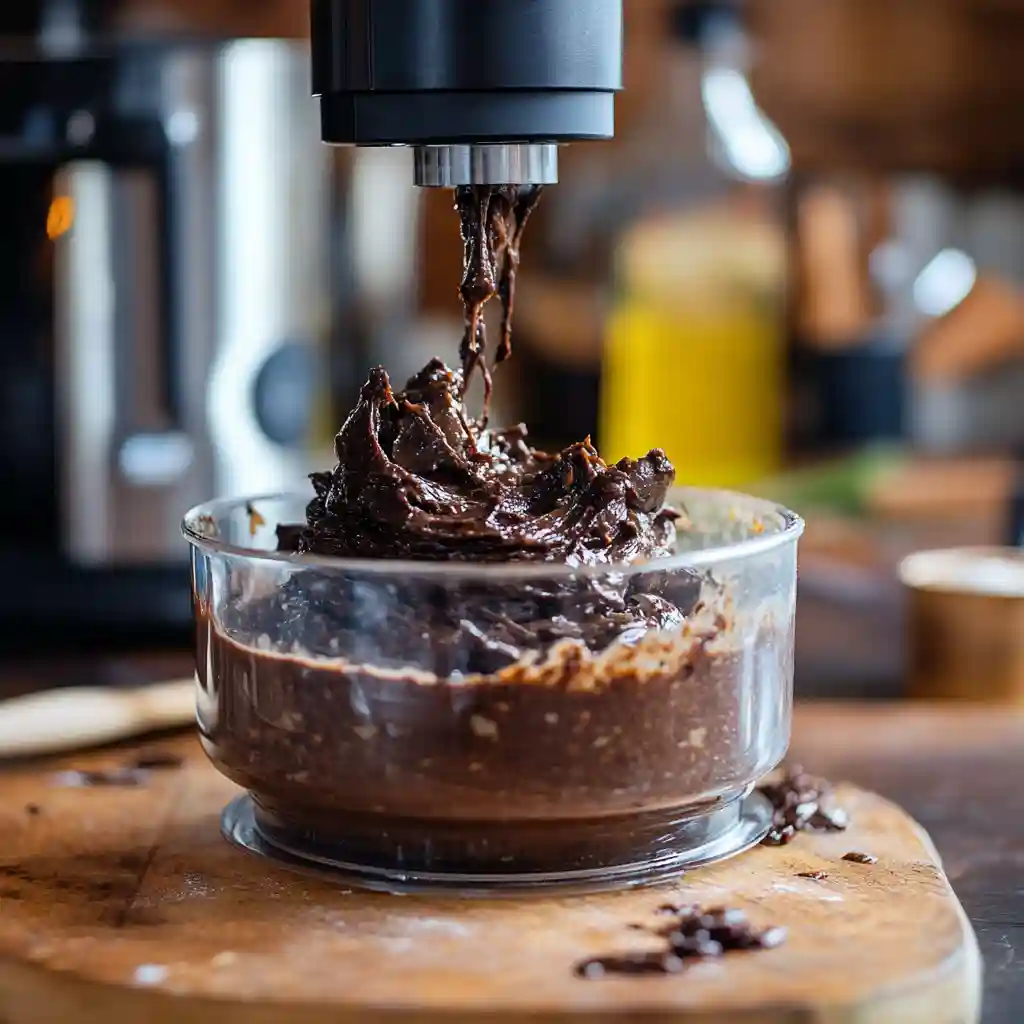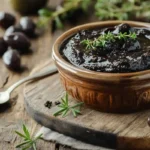
Table of Contents
Black olive spread is more than just a dip—it’s a Mediterranean classic that packs flavor, simplicity, and versatility into one small bowl. Whether you’re spreading it on crusty sourdough, spooning it into pasta, or layering it on a pizza, this savory paste adds depth to any dish. In this article, we’ll uncover what black olive spread really is, how it differs from traditional tapenade, what it’s made of, and why it’s surprisingly good for you. Plus, I’ll share a personal story that’ll take you from childhood lunchboxes to party platters. Let’s dive into the briny brilliance of black olive spread.
Why Black Olive Spread Deserves a Spot in Your Kitchen
A nostalgic beginning with black olive spread
I was around ten when I first tried black olive spread. My mom had brought back something mysterious from the farmers’ market—dark, shiny, and intense. She spread it on a slice of warm sourdough, handed it to me, and said, “Tell me what you think.” The moment I bit into it, the savory, garlicky flavor exploded across my tongue. It was earthy and bold, and I was instantly obsessed.
We never called it black olive spread. It was just something she whipped up from pantry staples: leftover black olives, garlic, capers, and a splash of olive oil. Years later, I’d learn this flavor-packed paste had a name—olive tapenade—and that it originated from the Mediterranean, especially Provence and Southern Italy. That tiny bowl became a staple in our family meals, often showing up on charcuterie boards or layered under roasted vegetables.
The simplicity and power of this plant-based favorite
Black olive spread might sound fancy, but it’s beautifully simple. All you need is a food processor, good-quality olives, and five minutes. The result? A deeply flavorful spread that works just as well on rustic bread as it does dolloped over grain bowls or stirred into pasta. I often pair it with flatbreads or use it to give depth to simple dishes like this vibrant green olive pizza.
When I want something richer but still clean, I spoon it into lentil salads or tuck it into roasted wraps. It even shines in quick meals like green olive soup when I’m pressed for time but craving bold flavor.
Black olive spread isn’t just a condiment. It’s a connection to tradition, a spark of creativity, and a reminder that the most unforgettable flavors often come from the simplest ingredients.
How to Make a Bold and Creamy Black Olive Spread at Home
Simple ingredients that pack a punch

The beauty of black olive spread lies in how little it takes to make something this flavorful. At its heart, the spread uses a handful of pantry staples—each chosen for depth and boldness. Here’s what you need:
- 1 cup pitted black olives (preferably oil-cured or Kalamata-style)
- 1 garlic clove
- 1 tablespoon capers (drained)
- 2 tablespoons fresh lemon juice
- 2 tablespoons extra virgin olive oil
- Optional: pinch of fresh thyme or rosemary for a twist
These ingredients create a naturally briny, garlicky flavor that doesn’t need much tweaking. For variety, some cooks add anchovies, but I skip them in my plant-based version.
Step-by-step: from olives to irresistible spread

Making black olive spread takes five minutes, tops. All it takes is a food processor or a powerful blender. Here’s how:
- Add ingredients to processor. Toss in your olives, garlic, capers, and lemon juice.
- Blend until coarse. Pulse briefly until you reach a chunky consistency.
- Drizzle olive oil. With the motor running, stream in olive oil slowly until the mix becomes spreadable.
- Taste and adjust. Add more lemon or herbs if you like.
- Serve or store. Spread on toast, dollop into pastas, or chill in a jar for up to a week.
For a sharper edge, try blending in a teaspoon of sundried tomato or roasted red pepper. I also love using it as a sandwich base under roasted vegetables or paired with a rustic grain bowl like the one in this Spanish rice with green olives.
And if you’re wondering whether this indulgent little spread is good for you—the answer is yes. Black olives are rich in vitamin E and antioxidants that support heart and brain health. You can read more about their full health benefits on WebMD.
Black Olive Spread vs Tapenade: What’s the Real Difference?
Understanding the difference between tapenade and black olive spread
Many people use the terms “black olive spread” and “tapenade” interchangeably, and in most casual settings, that’s totally fine. But if you want to be precise, especially in the kitchen, there’s a subtle but interesting distinction.
Tapenade originates from Provence, France, and traditionally includes black olives, capers, olive oil, and anchovies. Black olive spread, on the other hand, is a broader term. It can refer to any puree made primarily with black olives—anchovy-free, vegan, herb-forward, or even creamy with nuts.
Here’s a quick breakdown:
| Feature | Tapenade | Black Olive Spread |
|---|---|---|
| Origin | Southern France | Varied (Mediterranean-inspired) |
| Anchovies | Yes (traditional) | Optional |
| Vegan-Friendly | No (usually) | Yes (easily made vegan) |
| Texture | Chunky to coarse | Smooth to creamy |
| Flavor | Briny, umami-rich | Bold, adaptable |
So, while all tapenades are olive spreads, not all olive spreads are tapenades. When I make my version, I keep it plant-based—no anchovies, just bold, clean flavors.
Creative ways to use black olive spread
Once you’ve made a batch, you’ll want to keep using it all week. Here are a few fun, plant-forward ways I like to serve it:
- As a dip for roasted carrots or pita chips
- Swirled into hummus for a twist on a classic
- Spread onto sandwiches with grilled eggplant or tofu
- Tucked into savory galettes or green olive bread
- Layered in wraps with avocado and sprouts
- On pizzas, like this one with green olive tapenade
You can even freeze leftovers in an ice cube tray—perfect for tossing into soups or sauces when you need a hit of Mediterranean flavor.
Is Black Olive Spread Good for You? Absolutely—Here’s Why
Nutritional value of black olive spread
If you’ve ever hesitated before adding a spoonful of black olive spread to your plate, let’s settle it now: this spread is packed with benefits. Made primarily from olives, olive oil, and a few aromatics, it delivers antioxidants, healthy fats, and flavor without the guilt.
Here’s a quick look at the nutritional snapshot per two-tablespoon serving:
| Nutrient | Amount |
|---|---|
| Calories | 90–120 kcal |
| Total Fat | 10g (mostly monounsaturated) |
| Sodium | 250–400mg (varies by olive type) |
| Fiber | 1g |
| Vitamin E | Excellent source |
Olives are naturally rich in vitamin E and polyphenols—compounds shown to reduce inflammation and oxidative stress. They’re also a source of iron, copper, and healthy fats that promote heart and brain health.
Health perks of eating black olive spread
When eaten in moderation and paired with whole foods, black olive spread can actually support a balanced, plant-based lifestyle. Here are just a few of the proven benefits:
- Supports heart health with monounsaturated fats
- Supports skin health and strengthens the immune system due to its vitamin E content.
- Protects against oxidative damage with powerful antioxidants
- Improves brain function via compounds like oleocanthal
- Aids digestion when combined with fiber-rich foods
- Enhances satiety in small portions, reducing the urge to over-snack
And because it’s so flavorful, you don’t need a lot to transform a dish. I use it as a garnish in lentil-based bowls or even paired with light starters like this marinated green olives recipe for contrast and balance.
Just be mindful of sodium—especially if you’re using store-bought olives or spreads. That’s why I always recommend making it yourself. It’s fresher, cleaner, and lets you control what goes in—like in this green olive paste variation.
So, is black olive spread good for you? Definitely—when it’s homemade, full of heart-healthy fats, and eaten with intention.
Frequently Asked Questions
What is black olive spread?
Black olive spread is a flavorful blend made with black olives, olive oil, garlic, and capers. It’s used as a dip, sandwich spread, or topping for pasta and flatbreads. The flavor is salty, earthy, and rich.
Is olive tapenade the same as olive spread?
Not exactly. Tapenade is a specific type of olive spread that traditionally includes anchovies and capers, originating from France. Olive spread is a broader term and can be made vegan or customized with different herbs and spices.
What is a tapenade made of?
Classic tapenade contains black olives, anchovies, capers, garlic, and olive oil. Variations may include lemon juice, herbs, or mustard. Vegan versions omit anchovies.
Is black olive spread good for you?
Yes. It’s rich in healthy fats, vitamin E, and antioxidants. When eaten in moderation, black olive spread can support heart, brain, and skin health. Just watch the sodium if using brined olives.
Conclusion
Black olive spread is proof that big flavor doesn’t need complexity. From my first childhood bite to the endless ways I use it in my kitchen today, this spread continues to inspire. It’s bold, briny, nutrient-rich, and endlessly versatile. Whether you’re making a plant-powered pizza, adding depth to a grain bowl, or creating a savory starter, this little spread always delivers.
Print
Black olive spread
- Total Time: 5 min
- Yield: 1 cup 1x
- Diet: Vegan
Description
A rich, savory black olive spread perfect for sandwiches, flatbreads, or dips. Made with garlic, capers, and olive oil.
Ingredients
1 cup pitted black olives
1 garlic clove
1 tbsp capers
2 tbsp lemon juice
2 tbsp extra virgin olive oil
Optional: pinch of fresh thyme or rosemary
Instructions
1. Add olives, garlic, capers, and lemon juice to food processor
2. Pulse until coarse
3. Stream in olive oil while blending
4. Taste and adjust seasoning
5. Serve or chill in airtight container
Notes
Use Kalamata or oil-cured olives for bold flavor
Refrigerate up to 1 week
Pairs well with sourdough, wraps, or roasted vegetables
- Prep Time: 5 min
- Cook Time: 0 min
- Category: Spread
- Method: Blended
- Cuisine: Mediterranean
Nutrition
- Serving Size: 2 tbsp
- Calories: 90
- Sugar: 0g
- Sodium: 300mg
- Fat: 10g
- Saturated Fat: 1.5g
- Unsaturated Fat: 8g
- Trans Fat: 0g
- Carbohydrates: 1g
- Fiber: 1g
- Protein: 0.5g
- Cholesterol: 0mg
Keywords: black olive spread, vegan tapenade, olive dip
